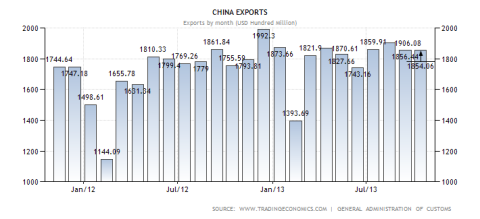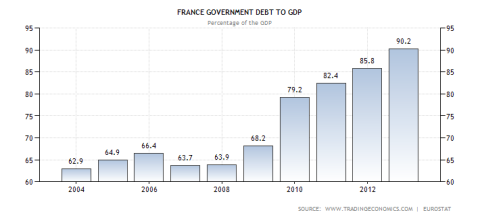Consumer Confidence in U.S. Drops for Sixth Consecutive Week – Bloomberg.

The economic data remains in definitely maybe mode. GDP grew at a decent clip close to 3% last quarter, but this does not help us answer the most important question of the day— are Americans growing more prosperous? Well, every week they are asked, and for the last six they have responded, “No.” In fact, removing the top 10% of earners from the survey would turn these poor results into dire ones. As usual in the New Normal, if you were rich enough to afford a Twitter allocation today, then you’re probably doing okay. If you’re not rich, not so much.
McKinsey Says 20% of Biggest Banks May Shrink or Merge – Bloomberg.
Credit Jobs at 10-Month Low as Borrowing Slows: EcoPulse – Bloomberg.

Chart from Google Finance
After outperforming the S&P 500 for years, the financial services sector ETF diverged lower in late August. Ongoing money printing is suppressing trading volumes while higher interest rates are simultaneously driving down new lending, particularly for mortgages. Lower activity levels point to future industry consolidation. The only question is will this happen through the M&A process, or will Fed-sponsored private bail-out program à la Bear Stearns?
Draghi Cuts ECB Rate to Fight ‘Prolonged’ Inflation Weakness – Bloomberg.
ECB cuts rates to new low, sees protracted low inflation | Reuters.
ECB Cuts Rates Unexpectedly as Low Inflation Threatens Recovery – WSJ.com.

Only 3 of 70 economists surveyed believed that there would be an ECB rate cut, but Draghi surprised everyone resulting in over a 150 pips drop in the USDEUR rate. The ECB and its German overlords must be much more concerned about future growth prospects than they have been letting on. Unfortunately for Europe, the weaker euro is temporary. An ongoing bank deleveraging in advance of 2014 ECB stress tests is causing banks to sell overseas assets and convert the proceeds into euros. Meanhwhile, the ECB’s failure to maintain the Fed’s torrid printing pace is raising the ECB/Fed balance sheet ratio to levels that imply a $1.54 USDEUR rate.
Once the rate cut proves ineffective, the Germans will reluctantly permit some sort of QE to maintain a favorable exchange rate, though the pretence given will have something to do with monetary transmission channels or some other wonkish nonsense.
U.S. growth picks up in third quarter as restocking offsets weak spending | Reuters.

GDP rose because firms increased inventories dramatically during the 3rd quarter. Of that 2.8% growth rate over 80bps are attributed to rising inventories. If firms increased stocks in anticipation of more business and they are correct, then growth may even surpass 3% next quarter. However, if the inventory surge was caused by a glut of unsold goods, then GDP growth will slow down from now until the end of the year.
I think that even the mainstream financial press is beginning to understand the economic situation. Today reports of 2.8% should have elicited more recovery hype, but the media’s reporting on 3rd quarter growth was rather subdued. Or, it could be that they are just too busy hyping the Twitter IPO to have paid much attention to GDP growth.
Jobless, US GDP data.

Journalists are neither statisticians nor data experts, so they really do not understand how to read the deluge of economic data being constantly released. Instead, they slavishly hew to a simplistic narrative involving unemployment claims and job creation. If either claims fall or there is positive job creation, the MFP consider this “improvement.”
This is the wrong way to view these numbers. Both data sets must be placed into context and reviewed with other data in order to create a complete picture of the American labor market. Jobless claims usually begin falling during a recession, and this is a leading indicator of recovery; however, low jobless claims in the middle of an expansion indicate that it is running out of steam. You can look at the chart and see for yourself what happens after jobless claims trough. (Hint: those gray columns indicate recessions)

The MFP also draws the incorrect conclusions from job creation data. The country needs about 200,000 new jobs per month to absorb new entrants into the labor force indicated by the red line:

The chart does not show an “improving” labor market, but a stagnant one. Essentially, after an initial burst of euphoria in 2010, the job market just got stuck. As long as job creation lags behind new entrants to the labor force, the labor market neither is improving nor will it improve.
As to why the labor market remains moribund despite the best efforts of the central bank, check out this chart:

Labor Force Participation Rate vs. Fed Assets
Must be a coincidence, huh?
Spain nears year-end funding target as industrial output grows | Reuters.

Despite my best efforts, the MFP’s Spanish Recovery Narrative, a subplot of the Euro Recovery Narrative continues unabated. Allow me to make another attempt by explaining this Reuter’s article passage by passage:
Spanish industry grew for the first time since early 2011 in September, data showed on Thursday, keeping investor sentiment towards the country upbeat as a strong debt sale brought the government close to hitting its 2013 funding target.
1. As long as the ECB funds virtually 100% of peripheral debt purchases practically for free, banks will continue to buy Spanish debt. Indeed, Eurozone TBTF banks increased their sovereign debt holdings by 26% last quarter. This is not a sign that Spain is recovering; rather, it is a sign that the ECB has a printing press.
Calendar-adjusted industrial output rose by a surprise 1.4 percent year-on-year in September, beating expectations of a 1.5 percent contraction and marking its first growth on an annual basis since February 2011.
2. A one month change could indicate an anomalous result. Certainly, we should expect to see several months in a row of expanding output. A trend like that would be something to write an article about, but an isolated rise after 25 months of contractions, meh.
Meanwhile, the Treasury easily sold 4 billion euros ($5.4 billion) in mid- and long-term bonds and has now shifted 96 percent of its 121.3-billion-euro year-end target.
An improved outlook for the Spanish economy from ratings agency Fitch also boosted demand for the 2018, 2023 and 2026 bonds offered.
That helped lower the price paid by the Treasury – a trend of declining yields that seems likely to continue following Thursday’s surprise interest rate cut by the European Central Bank, which occurred after the debt sale.
The 10-year bond yielded 4.164 percent, the lowest since September 2010 and a long way from rates of over 7.6 percent hit during the height of the debt crisis in the summer of 2012.
3. I don’t need to explain why Spanish rate optics are improving again. See #1 above.
Spain has languished in an economic slump since a property bubble burst in 2008, dragged down by depressed consumption in the face of record high unemployment.
That led nervous investors to demand unsustainable premiums to hold Spanish paper.
But an ECB pledge to do whatever it takes to back struggling euro zone economies, expansive monetary policies in the United States and Japan and the correction of fiscal and economic imbalances in the country have helped ease concerns.
Spain’s economy registered its first expansion in over two years in the third quarter thanks to strong exports, which also boosted capital goods production and lifted the headline industrial output figure.
“All the indicators point to a turnaround, and that we’re entering into growth. The doubt remains on whether it will be strong or weak, but it’s clear we’re passing from a period of recession to a period of growth,” said Nicolas Lopez,analyst at Madrid broker M&G Valores.
4. The passage above is an excellent nutshell review of the Spanish Recovery Narrative topped by some encouraging words from a permabull stockbroker. Much to most Spaniards’ great chagrin, all indicators do not point to a turnaround, only those which can be manipulated by the central bank like interest rates and stock market indices. Now, if there were only a way to teach central banks to print well-paying jobs rather than speculative cash for the TBTF banks and corporations, you wouldn’t be reading this, and more importantly, I wouldn’t be writing this.
Fitch last week raised its outlook on Spain’s debt, adding to the wave of improving sentiment and encouraging investors to bid for relatively high-yielding paper the Treasury is selling compared to many of its euro zone peers.
Debt in the euro-zone’s once-shunned peripheral economies has attracted strong demand in recent months and Spain’s auction came after Italy raised a record 22.3 billion euros from a four-year inflation-linked bond this week.
On Thursday, the Spanish Treasury sold 4.03 billion euros, beating the targeted range of between 3 billion and 4 billion euros and clearing the way for pre-financing 2014 borrowing.
While the recent economic data has helped fuel rising optimism toward Spain, some economists were more cautious about the strength of the recovery.
“This is another strong auction of Spanish debt and a confirmation, if one were needed, that Spain’s problem isn’t on the funding front, but rather on the fiscal and economic ones,” said Nicholas Spiro, managing director at Spiro Sovereign Strategy, echoing many other analysts’ views.
Spain’s export-led recovery is weighed down by continuing dire consumer demand which is not expected to grow until record levels of unemployment are dealt with. The European Commission sees Spain’s jobless rate remaining above 25 percent to 2016 at the earliest.
“Spain, like Italy, is very much a tale of two halves: a resilient and relatively buoyant bond market and a sickly economy whose public finances are going from bad to worse,” said Spiro.
5. Well, at last Spiro finishes up strongly for us while implying just what we explicitly stated above, specifically, that only the half of the system that can be affected by the ECB is performing adequately.












































You must be logged in to post a comment.